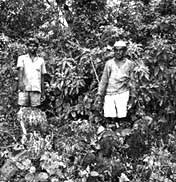Hunting for the snark
 Looking for solutions to a problem that has not even been identified properly is like hunting for the snark. Nobody has seen a snark and no one knows what it looks like. But common sense suggests that some measures could prevent aggravation of the situation.
Looking for solutions to a problem that has not even been identified properly is like hunting for the snark. Nobody has seen a snark and no one knows what it looks like. But common sense suggests that some measures could prevent aggravation of the situation.
First, there is a need to identify and map locations of sacred groves throughout India. Studies on sacred groves are far from satisfactory. "Comprehensive surveys are available only for a few states or regions like the Western Ghats, Coorg, and Kerala,' says K C Malhotra, professor of human ecology at the Indian Statistical Institute, Calcutta. The sacred groves in east, north and west India have hardly been studied. There is no scientific documentation of the sacred groves in the Himalayan region. "Sacred groves in the Kumaon hills in Uttar Pradesh are degrading at a rapid rate,' says K S Rao of the G B Pant Institute of Himalayan Environment and Development, Almora, on the basis of two surveys conducted by the institute in a period of five years.
What is more, existing surveys on the same area come up with different results. In Kerala, for instance, the number of sacred groves as reported by S Chand Basha, former principal chief conservator of forests, and N C Induchoodan, forest officer, are different. Furthermore, research reports mention degradation, but few explain the extent of loss in area and biodiversity.
The ministry of environment and forests woke up to the fact that sacred groves exist less than two years ago. It decided to launch some research projects in December 1996. But it has yet to identify experts, plan out the projects and obtain funds to conserve these islands of virgin biodiversity. Officials admit that they have no idea as to the total area under sacred groves in various states and the extent to which they are degraded.
What is to be done
The market economy has spread. Infrastructure development has made remote places accessible. Inaccessible areas are now connected to towns and cities. This has brought about a change in values. The
